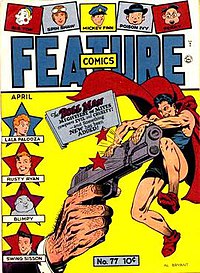
Quality Comics was an American comic book publishing company which operated from 1937 to 1956 and was a creative, influential force in what historians and fans call the Golden Age of Comic Books.
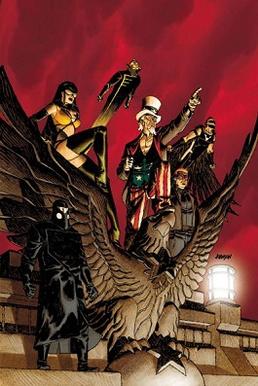
The Freedom Fighters is a superhero team appearing in American comic books published by DC Comics. The original six characters were the Black Condor, Doll Man, the Human Bomb, the Ray, the Phantom Lady, and Uncle Sam. Although the characters were created by Quality Comics, they never were gathered in a group before being acquired by DC. The team first appeared in a Justice League of America/Justice Society of America team-up, which ran in Justice League of America #107–108, written by Len Wein and drawn by Dick Dillin. Their own ongoing series premiered with Freedom Fighters #1, written by Gerry Conway and Martin Pasko, and drawn by Ric Estrada.
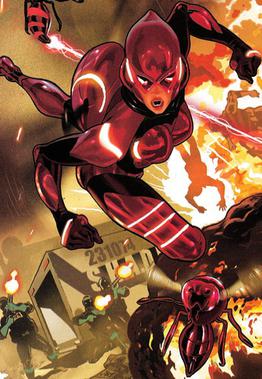
Red Bee is the name of two fictional superheroes appearing in American comic books.

The Crusaders is a team of DC Comics superheroes. The team was created by Bob Rozakis and Dick Ayers in the pages of Freedom Fighters #7. They were based on the Invaders and part of an unofiical crossover.
Miss America is a superheroine from the DC Comics Universe. She was first created by Quality Comics in Military Comics #1, and was carried over to DC Comics when they purchased Quality in the 1950s. While the original Golden Age character is in public domain, the subsequent versions created by DC Comics are not.

Phantom Lady is a fictional superheroine appearing in media published by Quality Comics and DC Comics. She was created by the Eisner & Iger studio, one of the first to produce comics on demand for publishers. The character's early adventures were drawn by Arthur Peddy.

The Human Bomb is a fictional superhero published by DC Comics. He first appeared in Police Comics #1, and was created by writer and artist Paul Gustavson.
"Alias the Spider" is a superhero feature from the Golden Age of Comic Books that appeared in Quality Comics' Crack Comics for nearly three years, starting with issue #1 in 1940. He was created by writer-artist Paul Gustavson.

Doll Girl is a fictional superhero from the Golden Age of Comics, originally published by Quality Comics and currently part of the DC Comics Universe of characters.
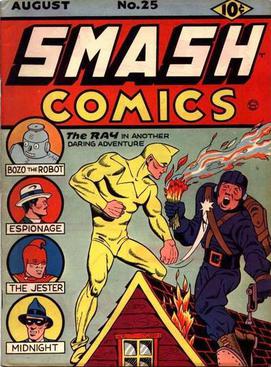
The Ray is the name of four superheroes in the DC Comics Universe. All versions of the character have the superpower of manipulating visible light in some manner.
Black Condor is the superhero name used by three different fictional characters in the DC Comics universe. All three incarnations of Black Condor have been members of the Freedom Fighters and each has been featured in Freedom Fighters comic books published by DC Comics.

Uncle Sam is a superhero appearing in American comic books published by DC Comics. Based on the national personification of the United States, Uncle Sam, the character first appeared in National Comics #1 and was created by Will Eisner.
Firebrand is a name of different characters appearing in American comic books published by DC Comics.

The Atom is a superhero appearing in American comic books published by DC Comics. The character was created by editor and co-plotter Julius Schwartz, writer Gardner Fox and penciler Gil Kane. The Atom was one of the first superheroes of the Silver Age of Comic Books and debuted in Showcase #34.

Neon the Unknown is a fictional superhero from the Golden Age of Comic Books created by Jerry Iger for Quality Comics. Neon first appeared in a story penciled and inked by Alex Blum in Hit Comics #1 and was featured on the cover of issue two drawn by Lou Fine. His stories ran in issues 1–17.

The Invisible Hood is a fictional superhero in the DC Comics Universe. He was originally owned by Quality Comics, but was later acquired by DC Comics, along with other Quality characters. He first appeared in Smash Comics #1, and was created by Art Pinajian, who illustrated the story under the pseudonym "Art Gordon".

Jester is a fictional character, a Golden Age superhero created by Paul Gustavson and published by Quality Comics. He first appeared in Smash Comics #22. Like most of Quality's characters, the Jester was later purchased by DC Comics and incorporated into their universe. Though little used by the company, he appeared in All-Star Squadron #31 and #60 and Starman #46. The character's last Golden Age appearance was in Smash Comics #85.

Superhero fiction is a subgenre of speculative fiction examining the adventures, personalities and ethics of costumed crime fighters known as superheroes, who often possess superhuman powers and battle similarly powered criminals known as supervillains. The genre primarily falls between hard fantasy and soft science fiction in the spectrum of scientific realism. It is most commonly associated with American comic books, though it has expanded into other media through adaptations and original works.
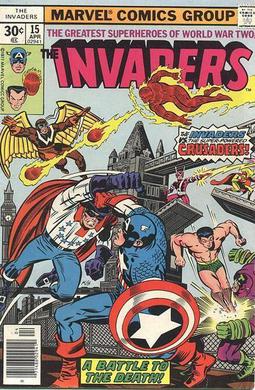
The Crusaders is a group of fictional characters appearing in American comic books published by Marvel Comics. The characters first appear in The Invaders #14 and were created by Roy Thomas, Jack Kirby, and Frank Robbins.
